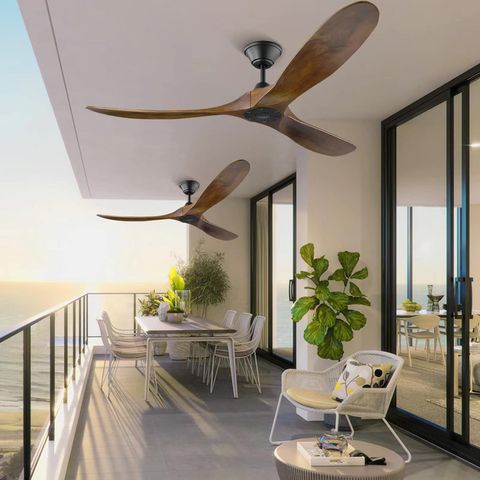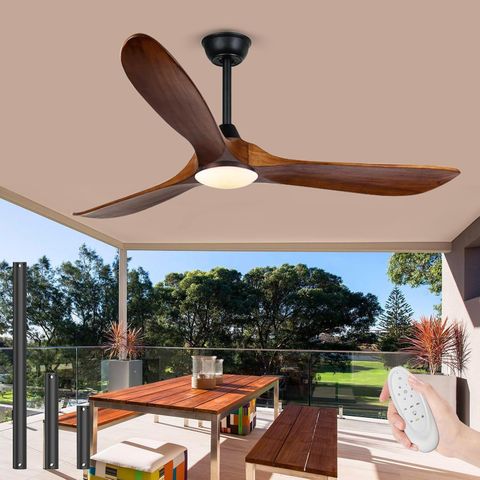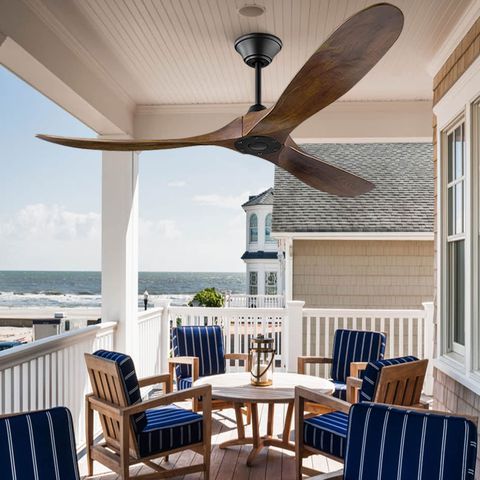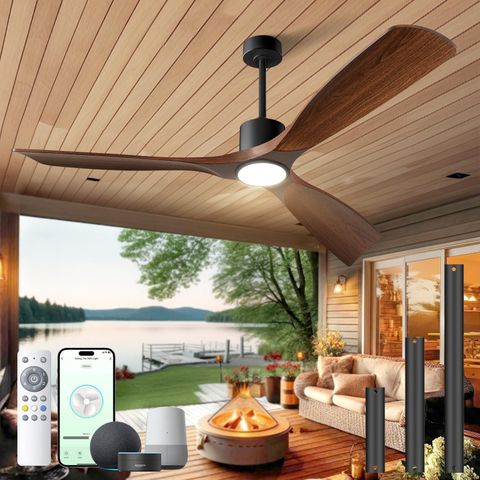Picture this: You’re sitting on your balcony, the sun is setting, and the gentle breeze is making everything feel just right. Now imagine if you could control that airflow with a simple switch. That’s exactly what a good outdoor ceiling fan can do for your modern balcony setup. It’s not just about staying cool – it’s about creating that perfect outdoor living experience.
Outdoor living spaces have become the crown jewel of modern homes. Balconies, patios, and rooftop decks are no longer just extensions of the house – they’re full-fledged entertainment zones, dining areas, and relaxation sanctuaries. But let’s be honest, the heat can quickly turn a pleasant evening into an uncomfortable ordeal. This is where outdoor ceiling fans step in to transform your balcony from a sweaty space into a comfortable retreat. Choosing the right one isn’t just about picking something that looks good – it’s about finding a fan that will withstand the elements while delivering the perfect amount of breeze. Every detail matters when it comes to outdoor fan selection, from the material choices to the blade design and motor strength.
Understanding Outdoor Fan Requirements
When you’re looking at outdoor ceiling fans, think beyond the typical indoor models. These aren’t just decorative pieces – they’re working tools that face constant exposure to weather, dust, and humidity. The key differences between indoor and outdoor fans are significant. Outdoor fans must be built tough to handle rain, wind, and UV rays. They typically feature corrosion-resistant materials like aluminum or stainless steel rather than delicate plastic components. Consider the size of your balcony too. A small balcony might only need a 36-inch fan, while larger spaces could benefit from 42-inch or even 52-inch models. The blade span determines how much air volume you’ll get, which directly impacts comfort levels. Think about how many people you’ll typically have on your balcony – this affects both the size and power requirements.
Material Matters: Durability and Weather Resistance
The materials used in outdoor ceiling fans can make or break their lifespan. Aluminum is often the go-to choice because it resists rust and corrosion better than other metals. Stainless steel offers exceptional durability, though it tends to be more expensive. Plastic components, while lighter, can degrade under prolonged sun exposure. Look for fans with powder-coated finishes that protect against fading and chipping. Some manufacturers offer special coatings that provide additional UV protection. When examining materials, pay attention to the motor housing as well. It should be sealed properly to prevent moisture damage. Check if the fan comes with a warranty specifically covering outdoor use – this often indicates confidence in the materials used. Real-world examples show that fans made with quality materials can last 15 to 20 years with proper maintenance.
Motor Power and Performance Factors
Not all motors are created equal, especially when it comes to outdoor applications. The motor needs to be powerful enough to move air efficiently while also being energy-efficient. Look for motors with high-quality bearings that reduce friction and extend life. Inverter technology is becoming increasingly common and offers better speed control and energy savings. Higher CFM ratings (cubic feet per minute) mean more airflow, but also more power consumption. For a typical balcony, you’ll want somewhere between 4,000 and 6,000 CFM. However, don’t assume bigger always means better – sometimes a well-designed smaller fan works more effectively than a massive model that’s overkill for your space. Speed settings matter too – multiple speeds allow you to adjust airflow based on conditions and personal preference. Some fans even come with remote controls for easy adjustment from anywhere in the room.
Blade Design and Airflow Efficiency
The blades on outdoor ceiling fans aren’t just for looks – they’re engineering marvels designed to move air effectively. Blade pitch angle is crucial; steeper angles move more air but can be louder. Most outdoor fans feature 12-15 degree pitch angles for optimal performance. Blade shape also matters – curved blades create smoother airflow compared to straight blades. The number of blades affects both airflow and noise levels. Three-blade designs are often quieter and more efficient, while four or five blades provide more airflow. Consider the blade material as well – some are made from durable plastics while others use wood or composite materials. The overall blade surface area determines how much air gets moved. A fan with larger blades generally provides better airflow than one with smaller blades, assuming all other factors are equal.
Installation Considerations and Mounting Options
Installing an outdoor ceiling fan requires more thought than indoor models. You’ll need to ensure your balcony’s ceiling can support the weight – typically 50-70 pounds for most outdoor fans. Check the mounting hardware provided by the manufacturer and verify it matches your ceiling type. Concrete or brick balconies might require different mounting solutions than wooden structures. Many outdoor fans come with adjustable mounting brackets to accommodate various ceiling heights. The distance from the ceiling to the fan blades should be at least 8 feet for safety and proper airflow. If you’re not confident in your installation skills, hiring a professional is worth the investment. Proper electrical connections are essential – outdoor fans need GFCI protection to prevent electrical hazards. Some installations require special electrical boxes or conduit work, so plan accordingly.
Maintenance and Longevity Tips
Outdoor ceiling fans demand regular care to maintain their performance and appearance. Cleaning schedules vary based on your environment – coastal areas may require monthly cleaning while inland locations might need quarterly attention. Remove blades carefully for cleaning, using mild soap and water. Pay special attention to the motor housing and electrical components. Lubricate moving parts according to manufacturer recommendations, usually every six months. Check for loose screws or bolts regularly, as vibration can cause them to loosen over time. Inspect the wiring periodically for signs of wear or damage. Some fans come with covers that protect the motor during harsh weather, which can extend the fan’s life significantly. Keeping a simple maintenance log helps track when tasks were last performed and ensures nothing gets overlooked.
Choosing the right outdoor ceiling fan for your modern balcony is an investment in comfort and lifestyle. It’s not just about selecting something that spins – it’s about finding a solution that integrates seamlessly with your outdoor living space. The key lies in understanding your specific needs, from the size of your balcony to the climate you live in. Take time to consider materials, motor quality, blade design, and installation requirements. Don’t overlook the importance of ongoing maintenance – a well-cared-for fan will serve you for many years. Remember that the best outdoor fan is one that makes your balcony feel like a true extension of your home, providing relief from heat while maintaining the elegant look you desire. Whether you’re entertaining guests or enjoying quiet evenings alone, the right outdoor ceiling fan transforms your space into a comfortable retreat year-round.














